Can You Put Drano in the Dishwasher? No & Why
Author: Anne Cowart | Editor: Omar Alonso
Review & Research: Jen Worst & Chris Miller

Is your dishwasher clogged? It's a convenient appliance when it's working, and you only realize the value it offers your household when it breaks down. If you're standing in the kitchen wondering what to do about it, you might think, "can you put Drano in the dishwasher?"
After all, Drano removes clogs in your pipes in seconds, so won't it do the same for your dishwasher? Is it the right product to use in the appliance, or could you damage the machine?
Either way, you'll have to do something soon, or your dishes will start piling up, which means you'll have to do them by hand – what a pain. This post unpacks everything you need to know about using Drano in your dishwasher.
Can You Put Drano in the Dishwasher to Unclog It?
Drano is one of the most well-known home detergent brands in America. It's great for dissolving clogs in the plumbing around your home. Unfortunately, Drano isn't the best choice to remove clogs in appliances like the dishwasher and washing machine.
Drano contains caustic chemicals that damage your dishwasher's plastics and operating components. Using Drano in any type of dishwasher could damage the parts and leave toxic residues that create health issues for your and your family.
What are the Active Ingredients in Drano?
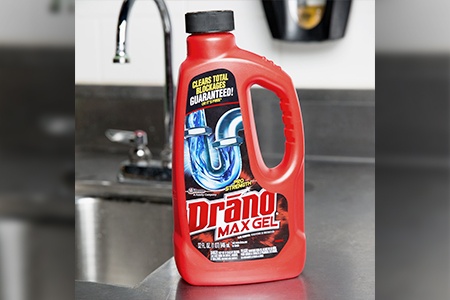
Drano makes a range of products. So, are any of them safe to use in your dishwasher? The products range from pouring liquids to foaming gels. Unfortunately, all Drano products contain similar ingredients, including bleach, sodium hydroxide, and aluminum.
Some homeowners might think using bleach in their dishwashers to remove clogs is a bad idea. It is, especially when mixed with hot water and even trying to figure out how to dispose of bleach. Not to mention having to get rid of the bleach smell after using it.
You can't use bleach in your dishwasher, period. The dishwasher runs hot, and the hot water mixes with the bleach, causing a chemical reaction. This reaction creates deadly chlorine gas, which is incredibly toxic and potentially fatal if you breathe it in. The gas could scar and damage your lungs and throat and burn your eyes.
As bad as bleach is in this regard, Drano is far worse. It's more caustic and toxic than bleach, and it's a bigger threat to the service life of your dishwasher.
While bleach is an aggressive chemical, it's nothing compared to the sodium hydroxide found in Drano. Also known as "lye," sodium hydroxide is the most dangerous and "caustic" chemical in Drano, something you want to stay away from getting on your skin and in your lungs.
Lye is great for dissolving fat and congealed grease blocking your drains, but it doesn't belong in the dishwasher. When sodium hydroxide works in combination with aluminum, also found in the Drano formulation, it creates a highly aggressive cleaning chemical capable of eliminating the most stubborn blockages in plumbing and drains.
The combination of bleach, sodium hydroxide, and aluminum in Drano starts a thermal reaction when you pour it into the drain. There's enough thermal energy that some manufacturers use these chemicals to create explosives. Please do not mix them.
How Does Using Drano in My Dishwasher Affect Its Performance?
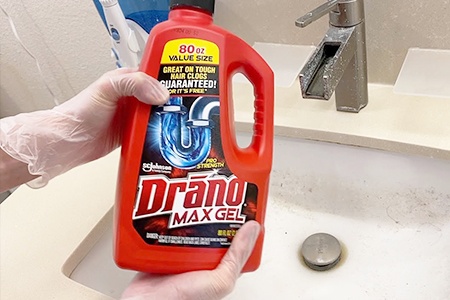
Can you put Drano in the dishwasher? Let's think it through. So, as a thought experiment, what would happen if you poured a small quantity of Drano into the soap compartment in your dishwasher, closed the door, and started the machine? Would it explode? Let's look at what goes on inside the appliance and how it affects its operation.
As the machine comes to life and starts the wash cycle, you won't notice any problems at first. As the Drano spreads through the dishwasher, it generates thermal energy, combining with the hot water to create a super-heated mixture of toxic ingredients.
The huge amount of thermal energy created during this chain reaction will melt the plastic components of the appliance, like the drain pump. This malfunction prevents the machine from draining, leading to flooding all over your kitchen floor as the water escapes the machine.
Replacing the drain pump is expensive, and you can expect it to set you back around $375 for the part and more money for an agent's labor to fix the machine. This also considers that the drain pump is only partially destroyed by the Drano. The reality is there are many other components susceptible to the thermal damage created by the cleaner.
Along with the mechanical damage to the appliance, the Drano coats the interior of the wash chamber in the machine. As a result, you line its interior with toxic chemicals like lye and bleach. IT could take several wash cycles to remove these chemicals from the machine as they are aggressive and cling to surfaces.
Signs of a Blocked Dishwasher
Can you put Drano in the dishwasher? Instead of resorting to pouring Drano into your dishwasher's soap compartment, focus on finding the source of the problem with the appliance. Here are a few indications you have a blockage in your dishwasher.
- The appliance makes a burbling sound during the wash cycle.
- The water in the machine backs up the drainage pipes and rises through the sink drain.
- The dishes, glasses, and crockery in the washer are still dirty after it finishes a cycle.
- There's water in the bottom of the appliance after the cycle finishes.
Check for a single or even multiples of these signs of a clogged dishwasher.
Why Does My Dishwasher Become Clogged?
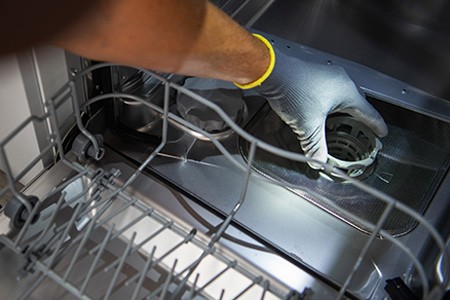
There could be several reasons why your dishwasher ends up clogging:
- You don't pre-rinse the dishes before placing them in the machine.
- You don't clean the drain filter regularly.
- There are mineral deposits from hard water clogging components.
- You use too much cleaning agent in the machine.
- You forget to remove the knockout plug in your garbage disposal.
- The garbage disposal is leaking, clogged, or malfunctions.
- You have blockages in your plumbing.
Check this list and see if you can identify and fix the problem. Call a professional plumber for assistance if you have no idea why your dishwasher stopped working. They work with dishwashers all the time and have plenty of experience fixing them. It might cost you a few dollars, but you'll spend less than the damage caused by pouring Drano into the appliance.
Things to Check if Your Dishwasher Isn't Draining
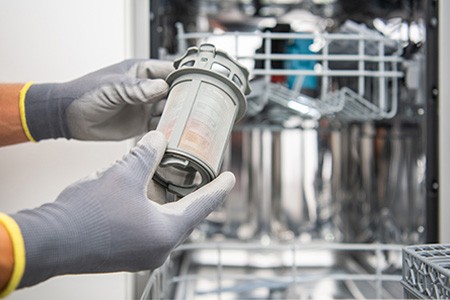
Before you jump straight to using harsh chemicals that you should prefer not to have around your dishes and utensils, try these following methods to see if you can locate the specific problem.
Clear the Garbage Disposal
Some homeowners have a setup where the water from the dishwasher drains through the garbage disposal. If that's the case in your kitchen, you'll need to keep the disposal clean and clear to allow the free running of water. You may even have drain flies in there, but still, though you can use Drano to kill drain flies, don't put it in the disposal either.
If the garbage disposal is full, the water backs up, leaving standing water in the appliance. Ensure you run your disposal and remove all clogs before calling the professionals. This simple hack could loosen debris and return your dishwasher to normal function.
Clean the Air Gap
Most kitchens have an air gap installed on the same counter as the sink, next to the faucet. It prevents the water from the sink from backing up into the dishwasher. If there are clogs in the air gap, it may cause the dishwasher to fail to drain properly. If you don't see one, you may have one of the dishwasher air gap alternatives.
Water flooding the counter is another common sign of a clogged air gap. Take off the air gap cap and remove any debris blocking the system.
Can I Use Vinegar & Baking Soda to Unclog My Dishwasher?
Instead of using Drano to unclog your dishwasher, consider other less-caustic options available around your home. Can you put Drano in the dishwasher? It's way too caustic and there's better choices. Vinegar is an acidic liquid acting as a holistic alternative to chemical cleaners. White spirit vinegar has enough cleaning power to cut through grease. You can even use salt to unclog a drain.
To optimize the grease-stripping power of vinegar, we recommend pairing it with baking soda for a stronger cleaning effect. Baking soda and vinegar are usually enough to dissolve some pretty stubborn clogs. Place a cup of vinegar and a cup of baking soda in the bottom drawer of your dishwasher, close it up and start the machine.
The vinegar and baking soda mix with the water in the machine as it starts working, dissolving the clogs. While this combination is usually effective, there might be times when it doesn't work. If that's the case for you, call a professional to clean the machine.
If it does work, you have a non-toxic way of cleaning the dishwasher. Plus, the baking soda absorbs bad odors, leaving your machine looking clean and smelling fresh.
A Quick Guide to Unclogging a Dishwasher
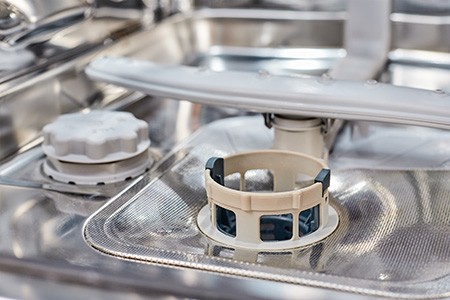
Don't try to unclog a dishwasher drain with Drano, as we've discussed. Follow the method below instead for a less damaging alternative.
Step 1 – Remove all items from the machine, along with the racks and filter.
Step 2 – Wear rubber gloves and clean visible debris from the pipes and filter. You're probably going to come across some nasty-smelling gunk, so you might want to wear a mask to limit the smell. Soak the filter in hot soapy water for a few hours to remove stubborn deposits.
Step 3 – Use a cup to scoop out the old water pooling at the bottom of the machine. Check the sprayer arms for blockages and clean them out using a toothpick or slim object.
Step 4 – Mix some warm water and white vinegar and place them on the top shelf of the dishwasher, along with a cup of baking soda. Run the dishwasher for a cycle. The vinegar loosens and removes clogs, while the fizzing action of the baking soda dissolves clogs and deodorizes the machine.
Step 5 – After completing the wash cycle, load the machine as normal and run it again to test it and see if your cleaning job worked. If you still notice signs of blockages, call a plumber or approved service agent to assist with fixing the machine.
So Can You Put Drano in the Dishwasher?
Is Drano safe for dishwashers? Using Drano in a dishwasher can clear a clog but it can also leave harmful chemical residues behind that can end up on your dishes and utensils.
These caustic chemicals can damage the plastic parts of your dishwasher as well, ultimately leading needing much more serious and expensive maintenance work being done, or a complete replacing of the dishwasher. So can you put Drano in the dishwasher? You can, but you should not.




